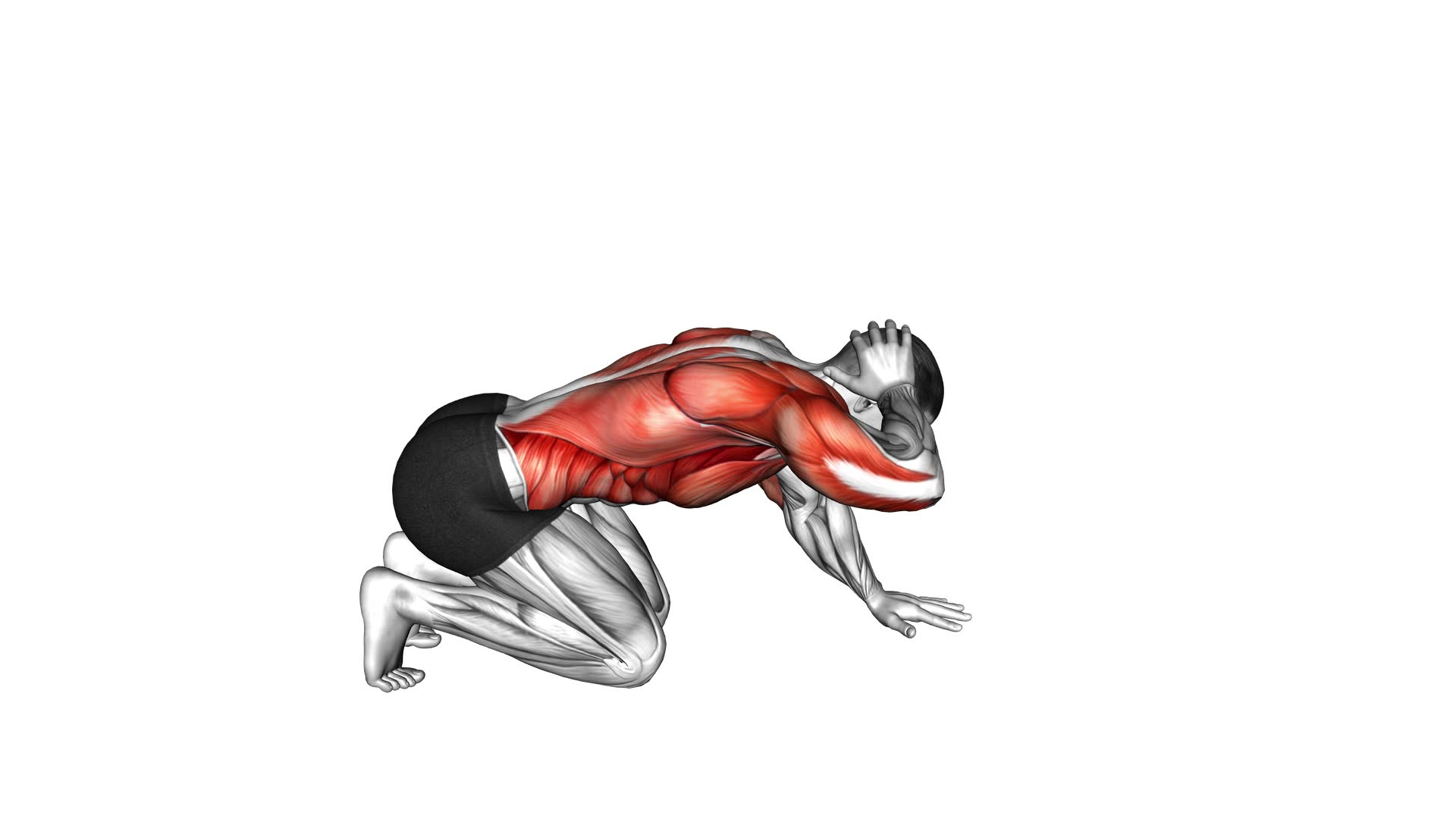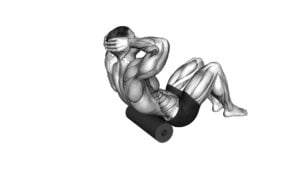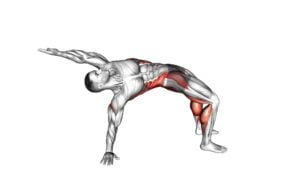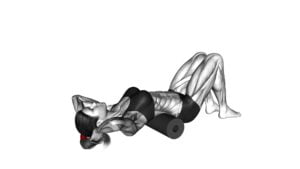Kneeling Thoracic Rotation (male) – Video Exercise Guide & Tips

In this video exercise guide, you'll learn the proper technique for the kneeling thoracic rotation. This exercise is designed to improve your upper back mobility and reduce stiffness.
Watch This Exercise Video
You'll only need a mat or soft surface to perform this movement. By following the tips and avoiding common mistakes, you'll maximize the effectiveness of this exercise.
If you're an advanced user, we'll also provide variations and progressions to challenge you further.
Let's get started and enhance your thoracic rotation!
Key Takeaways
- Kneeling thoracic rotation improves upper back mobility and reduces stiffness.
- Proper technique involves focusing on core activation, engaging abdominal muscles, and maintaining a stable core.
- Using proper technique increases core strength and stability, prevents injuries, and maximizes results.
- Common mistakes to avoid include incorrect spinal alignment, limited range of motion, lack of core engagement, and rounding of the upper back.
Benefits of Kneeling Thoracic Rotation
You can experience improved mobility and flexibility through regular practice of kneeling thoracic rotation. This exercise specifically targets the thoracic spine, which is the middle portion of your spine. By incorporating kneeling thoracic rotation into your routine, you can enhance your spinal mobility and achieve better posture.
The thoracic spine plays a crucial role in maintaining proper posture. Poor posture can lead to various issues such as back pain, muscle imbalances, and limited range of motion. Kneeling thoracic rotation helps to counteract these problems by targeting the muscles and joints in the thoracic region.
During the exercise, you'll be in a kneeling position with your hands placed behind your head. As you rotate your upper body to each side, you engage the muscles along your spine, promoting increased flexibility and mobility. This movement also helps to alleviate tension and tightness in the thoracic region, allowing for a more upright and aligned posture.
Incorporating kneeling thoracic rotation into your regular exercise routine can have a positive impact on your overall spinal health. By improving your spinal mobility and promoting better posture, you can reduce the risk of developing chronic pain and improve your overall quality of life.
Equipment Needed for the Exercise
To perform the kneeling thoracic rotation exercise, you'll need minimal equipment. Here are the items you'll need:
- Exercise mat: A comfortable and supportive mat will provide cushioning for your knees and ensure a stable surface for the exercise.
- Resistance band: Using a resistance band can add an extra challenge to the exercise by providing resistance as you rotate your upper body.
- Dumbbell or kettlebell: Holding a weight in your hands can help to increase the difficulty and intensity of the exercise.
- Towel or yoga strap: If you have limited flexibility or mobility in your shoulders, using a towel or yoga strap can assist you in reaching a full range of motion during the rotation.
- Mirror or video recording device: Having a mirror or video recording device can be helpful in monitoring your form and ensuring that you're performing the exercise correctly.
When performing the kneeling thoracic rotation exercise, it's important to keep safety precautions in mind. Make sure to choose an appropriate weight for your fitness level and gradually increase as you get stronger. Additionally, listen to your body and modify the exercise as needed. If you experience any pain or discomfort, stop the exercise immediately and consult a healthcare professional.
Proper Technique for Kneeling Thoracic Rotation
To perform the kneeling thoracic rotation exercise with proper technique, it's important to focus on core activation during rotation. Engage your abdominal muscles and maintain a stable core throughout the movement to enhance the effectiveness of the exercise.
Core Activation During Rotation
Engage your core muscles to maximize the effectiveness of the kneeling thoracic rotation exercise. Core stability and rotational strength are crucial for proper technique and optimal results.
To activate your core during the exercise, focus on the following:
- Keep your abdominal muscles tight and engaged throughout the movement.
- Imagine a string pulling your belly button towards your spine, creating a strong and stable core.
- Maintain a neutral spine position by avoiding excessive arching or rounding of the back.
- Control your breathing, exhaling as you rotate and inhaling as you return to the starting position.
- Visualize your core muscles working together to support your spine and enhance the rotational movement.
Benefits of Proper Technique
By mastering the proper technique for kneeling thoracic rotation, you can unlock a range of benefits for your core strength and rotational mobility. Maximizing results is one of the main advantages of performing this exercise correctly.
When executed with proper form, kneeling thoracic rotation targets and activates the muscles in your core, including the obliques and deep stabilizers, leading to increased strength and stability. Additionally, by maintaining proper technique, you can also prevent injuries. Engaging your core muscles and maintaining proper alignment throughout the movement helps to protect your spine and surrounding structures from unnecessary strain.
By focusing on proper form and technique, you can ensure that you're getting the most out of this exercise while minimizing the risk of injury.
Now, let's move on to the next section and discuss common mistakes to avoid.
Common Mistakes to Avoid
When performing the kneeling thoracic rotation exercise, there are several common mistakes that you should avoid.
One mistake is incorrect spinal alignment, which can put unnecessary strain on your back and limit the effectiveness of the exercise.
Another mistake is having a limited range of motion, which can prevent you from fully engaging your thoracic spine.
Lastly, lack of core engagement can lead to poor stability and decrease the effectiveness of the exercise.
Incorrect Spinal Alignment
To maintain proper form and avoid potential injury, ensure that your spine is aligned correctly during the kneeling thoracic rotation exercise. Proper spinal alignment is of utmost importance as it allows for optimal movement and function of the entire body. Incorrect alignment, on the other hand, can have serious consequences.
Here are five common mistakes to avoid when it comes to spinal alignment during this exercise:
- Avoid rounding your upper back, as this can put excessive strain on the spine.
- Keep your shoulders relaxed and avoid hunching them forward, which can lead to poor posture.
- Make sure your neck is in a neutral position, avoiding excessive tilting or rotation.
- Engage your core muscles to support your spine and maintain stability.
- Avoid overarching your lower back, as this can cause compression and discomfort.
By maintaining proper spinal alignment, you can prevent injury and ensure effective execution of the kneeling thoracic rotation exercise.
This will set the stage for the subsequent section about limited range of motion.
Limited Range of Motion
Maintain proper form and avoid potential injury by addressing limited range of motion during the kneeling thoracic rotation exercise. Limited range of motion can hinder your progress in maximizing flexibility and improving posture.
To avoid this common mistake, ensure that you're properly warmed up before starting the exercise. Incorporate dynamic stretches that target the thoracic spine, such as arm swings and trunk rotations, to improve mobility in this area.
Additionally, it's important to listen to your body and not push past your limits. Gradually increase the range of motion as your flexibility improves over time.
Lack of Core Engagement
To prevent a lack of core engagement, focus on activating your abdominal muscles throughout the kneeling thoracic rotation exercise. This will help improve your core stability and prevent muscle imbalances. Here are some tips to ensure proper core engagement during the exercise:
- Imagine pulling your belly button towards your spine to engage your deep core muscles.
- Keep your core muscles tight and engaged throughout the entire movement.
- Avoid arching or rounding your lower back, as this can lead to a lack of core engagement.
- Maintain a neutral spine position to ensure proper alignment and engagement of your core.
- Breathe deeply and exhale as you rotate, using your core muscles to initiate and control the movement.
Tips for Maximizing the Effectiveness of the Exercise
Maximize the effectiveness of the exercise by focusing on proper form and engaging the core muscles. To maximize results and improve flexibility, it's crucial to maintain proper alignment throughout the movement. Start by ensuring that your spine is in a neutral position, with your shoulders down and relaxed. As you rotate, keep your core muscles engaged to stabilize your spine and prevent excessive movement in the hips and lower back.
To engage your core effectively, imagine drawing your belly button towards your spine, creating a slight contraction in your abdominal muscles. This activation will provide stability and control during the exercise. Additionally, keep your chest lifted and your shoulders relaxed to maintain proper posture.
Remember to breathe throughout the movement, inhaling deeply as you rotate and exhaling as you return to the starting position. This conscious breathing will help you maintain focus and enhance the effectiveness of the exercise.
By following these tips, you can maximize the effectiveness of the kneeling thoracic rotation exercise and achieve better results in terms of flexibility and core strength.
Now let's explore some variations and progressions for advanced users to continue challenging themselves and further improve their fitness levels.
Variations and Progressions for Advanced Users
For advanced users, you can further challenge yourself and improve your fitness levels by incorporating variations and progressions into the kneeling thoracic rotation exercise. By modifying the exercise, you can target different muscles and enhance the difficulty of the movement.
Here are five variations and progressions to try:
- Weighted Kneeling Thoracic Rotation: Hold a dumbbell or kettlebell in your hands as you rotate, adding resistance to the exercise.
- Single-Arm Kneeling Thoracic Rotation: Perform the exercise while holding a weight in only one hand, focusing on stability and control.
- Kneeling Thoracic Rotation with Resistance Band: Attach a resistance band to a stable anchor and hold the other end while rotating, increasing the challenge on your core muscles.
- Kneeling Thoracic Rotation with Medicine Ball: Hold a medicine ball against your chest as you rotate, adding weight and requiring more stability.
- Kneeling Thoracic Rotation with Overhead Reach: Extend your arms overhead as you rotate, increasing the range of motion and engaging your shoulder muscles.
Incorporating these variations and modifications into your kneeling thoracic rotation exercise routine won't only keep your workouts interesting but also help you progress and achieve your fitness goals.
Remember to start with lighter weights or resistance bands and gradually increase the difficulty as you become more comfortable and confident with the exercise.
Frequently Asked Questions
How Often Should I Perform the Kneeling Thoracic Rotation Exercise?
To determine how often you should perform the kneeling thoracic rotation exercise, consider your goals and current fitness level. This exercise can be done standing as well.
As a general guideline, aim to incorporate it into your routine 2-3 times a week. However, it's always best to consult with a fitness professional or your healthcare provider for personalized advice. They can help tailor a program that suits your specific needs and ensures proper form and safety.
Can This Exercise Help Improve My Posture?
Yes, the kneeling thoracic rotation exercise can definitely help improve your posture.
By engaging the muscles in your thoracic spine and upper back, this exercise promotes better alignment and mobility, which are key factors for maintaining good posture.
The rotational movement also helps to release tension and tightness, allowing for a more upright and balanced posture.
Incorporating this exercise into your routine can provide you with the benefits of thoracic rotation and contribute to overall improved posture.
Is It Safe to Perform the Kneeling Thoracic Rotation Exercise if I Have a History of Back Pain?
When dealing with a history of back pain, it's important to prioritize safety.
The kneeling thoracic rotation exercise can be beneficial for improving posture, but modifications may be necessary to accommodate your condition.
It's recommended to consult with a healthcare professional or a qualified trainer who can assess your specific situation and provide guidance on how to safely perform this exercise.
Can I Incorporate Weights or Resistance Bands Into This Exercise for Added Intensity?
Yes, you can definitely incorporate weights or resistance bands into the kneeling thoracic rotation exercise to add intensity. By using weights or resistance bands, you're challenging your muscles and increasing the difficulty of the exercise. This can help you build strength and improve your overall performance.
However, it's important to start with lighter weights or bands and gradually increase the resistance as you become more comfortable and confident with the exercise. Always listen to your body and consult with a professional if you have any concerns.
Are There Any Modifications I Can Make to Accommodate for Limited Mobility or Flexibility?
To accommodate limited mobility or flexibility, there are some modifications you can make to the kneeling thoracic rotation exercise.
One option is to perform the movement in a seated position instead of kneeling. This will reduce the strain on your knees and make it easier to rotate your upper body.
Another modification is to use a foam roller or a yoga block to support your knees or hips, providing additional stability.
These modifications can help you still reap the benefits of the kneeling thoracic rotation exercise.
Conclusion
Incorporating kneeling thoracic rotations into your exercise routine can provide numerous benefits, including improved mobility and flexibility in the thoracic spine. By following proper technique and avoiding common mistakes, you can maximize the effectiveness of this exercise.
Additionally, advanced users can explore variations and progressions to challenge themselves further. Remember to consult with a fitness professional before attempting any new exercises to ensure safety and proper form.

Author
Years ago, the spark of my life’s passion ignited in my mind the moment I stepped into the local gym for the first time. The inaugural bead of perspiration, the initial endeavor, the very first surge of endorphins, and a sense of pride that washed over me post-workout marked the beginning of my deep-seated interest in strength sports, fitness, and sports nutrition. This very curiosity blossomed rapidly into a profound fascination, propelling me to earn a Master’s degree in Physical Education from the Academy of Physical Education in Krakow, followed by a Sports Manager diploma from the Jagiellonian University. My journey of growth led me to gain more specialized qualifications, such as being a certified personal trainer with a focus on sports dietetics, a lifeguard, and an instructor for wellness and corrective gymnastics. Theoretical knowledge paired seamlessly with practical experience, reinforcing my belief that the transformation of individuals under my guidance was also a reflection of my personal growth. This belief holds true even today. Each day, I strive to push the boundaries and explore new realms. These realms gently elevate me to greater heights. The unique combination of passion for my field and the continuous quest for growth fuels my drive to break new ground.







